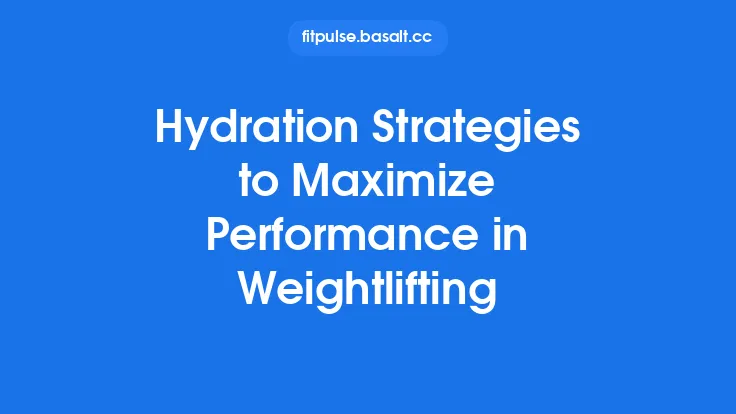After a hard‑fought training session, the most immediate question on many athletes’ minds is simple yet crucial: How much water do I actually need to replace?
Unlike generic “drink eight glasses a day” advice, post‑exercise fluid replacement must be personalized. It hinges on how much you sweated, the conditions you trained in, your body size, and even the type of activity you performed. By treating hydration as a calculable variable rather than a vague habit, you can safeguard performance, speed recovery, and reduce the risk of dehydration‑related setbacks.
Understanding Sweat Loss: The Basics
Sweat is the body’s primary cooling mechanism. When you exercise, core temperature rises, prompting sweat glands to release fluid onto the skin’s surface. As this fluid evaporates, heat dissipates, keeping you from overheating. The amount of sweat produced varies dramatically:
| Variable | Typical Impact on Sweat Rate |
|---|---|
| Exercise intensity | Higher intensity → more metabolic heat → higher sweat output |
| Duration | Longer sessions give the body more time to accumulate fluid loss |
| Environmental heat & humidity | Hot, humid conditions dramatically increase sweat volume |
| Clothing & equipment | Heavy, non‑breathable gear traps heat, raising sweat |
| Acclimatization | Well‑acclimated athletes may sweat more efficiently (more sweat, but less electrolyte loss per volume) |
| Individual physiology | Genetics, fitness level, and body surface area all play a role |
On average, most people lose 0.5–2.0 L of sweat per hour. Elite endurance athletes can exceed 3 L/h in extreme heat. Knowing where you fall on this spectrum is the first step toward accurate fluid replacement.
Measuring Your Personal Sweat Rate
The most reliable way to personalize hydration is to measure your own sweat loss. The process is straightforward and requires only a scale, a towel, and a stopwatch (or a timer on your phone).
- Weigh‑in before exercise
- Empty your bladder, remove excess clothing, and step on a calibrated digital scale. Record the weight in kilograms (kg) or pounds (lb).
- Note the exact time you start your workout.
- Exercise as usual
- Keep a normal training intensity and duration. If you’re testing for a specific session type (e.g., a 60‑minute run), replicate that.
- Weigh‑in after exercise
- Immediately after finishing, towel off any visible sweat, then weigh yourself again under the same clothing conditions.
- Record the post‑exercise weight.
- Account for fluid intake
- If you drank water or sports drinks during the session, note the volume (in milliliters or ounces).
- Calculate sweat loss
- Weight loss (kg) = Pre‑exercise weight – Post‑exercise weight
- Convert weight loss to fluid loss (1 kg ≈ 1 L of water).
- Total sweat loss (L) = Weight loss (L) + Fluid consumed (L)
- Derive sweat rate
- Sweat rate (L/h) = Total sweat loss ÷ Exercise duration (h)
Example:
- Pre‑exercise weight: 78.0 kg
- Post‑exercise weight: 77.2 kg
- Fluid consumed: 0.5 L
- Weight loss = 0.8 kg → 0.8 L
- Total sweat loss = 0.8 L + 0.5 L = 1.3 L
- Duration = 1 h → Sweat rate = 1.3 L/h
Repeating this test under different environmental conditions (cool vs. hot, indoor vs. outdoor) builds a library of personal sweat rates you can reference later.
Factors That Influence Fluid Requirements
Even with a solid sweat‑rate baseline, several variables can shift your immediate fluid needs:
| Factor | How It Alters Needs |
|---|---|
| Ambient temperature | Warmer air raises sweat rate; cooler air may reduce it |
| Relative humidity | High humidity impairs evaporation, prompting the body to produce more sweat to achieve cooling |
| Altitude | Lower air pressure can increase respiratory water loss |
| Body size & composition | Larger surface area → more heat exchange → higher sweat volume |
| Training status | Well‑trained athletes often have more efficient thermoregulation, sometimes resulting in higher sweat rates but lower core temperature rise |
| Acclimatization level | Acclimated individuals start sweating earlier and more profusely, which can actually protect against overheating |
| Clothing & gear | Insulating or non‑breathable fabrics trap heat, increasing sweat output |
| Hydration status before training | Starting dehydrated can blunt sweat production, but also raises the risk of further fluid deficit |
Understanding these modifiers helps you adjust the raw sweat‑rate number to the specific context of each workout.
Calculating Fluid Replacement Needs
With a measured sweat rate and an awareness of situational modifiers, you can compute a personalized fluid replacement target. The goal is to replace roughly 100–150 % of the fluid lost within the first few hours post‑exercise. The extra 0–50 % accounts for ongoing losses through respiration and urine.
Step‑by‑step formula
- Determine sweat loss for the session
\[
\text{Sweat loss (L)} = \text{Sweat rate (L/h)} \times \text{Duration (h)}
\]
- Add a safety margin (10–50 %)
\[
\text{Target replacement (L)} = \text{Sweat loss} \times (1.0 \text{ to } 1.5)
\]
- Adjust for environmental modifiers
- Hot & humid: Use the upper end of the 1.5 multiplier.
- Cool & dry: Stay closer to 1.0–1.2.
- Distribute intake over time
- Immediate window (0–30 min): Aim for 0.5 L (or ~17 oz) of fluid.
- Next 2–4 h: Consume the remaining volume in regular, sip‑sized portions (e.g., 200–300 mL every 15–20 min).
Practical example:
- Sweat rate = 1.2 L/h
- Session length = 1.5 h → Sweat loss = 1.8 L
- Training in 30 °C, 70 % humidity → use 1.4 multiplier
- Target replacement = 1.8 L × 1.4 = 2.52 L
Thus, you would aim to drink roughly 2.5 L of fluid over the next 2–4 hours, beginning with a half‑liter right after the workout.
Practical Tools and Apps for Tracking
Manual calculations are reliable, but technology can streamline the process and keep you consistent.
| Tool | Core Feature | How It Helps |
|---|---|---|
| Hydration‑Calc (iOS/Android) | Input weight, duration, temperature, and perceived sweat intensity | Generates a personalized fluid target and sends reminder notifications |
| MyFitnessPal (custom entries) | Allows you to log fluid intake alongside nutrition | Provides a visual daily fluid balance chart |
| Garmin/Polar watch sweat‑rate estimators | Uses heart‑rate, temperature, and activity data to estimate sweat loss | Offers real‑time guidance during long sessions |
| Excel/Google Sheets template | Simple spreadsheet with formulas for sweat‑rate, replacement, and margin | Enables you to keep a historical log and spot trends |
| Smart water bottles (e.g., HidrateSpark) | LED feedback and app sync to track daily intake | Encourages consistent sipping throughout the post‑workout window |
Whichever method you choose, the key is regular logging. Over weeks, patterns emerge that let you fine‑tune your fluid plan without re‑measuring every session.
Hydration Hacks for Real‑World Situations
Even with a solid plan, life throws curveballs. Below are evidence‑based shortcuts that keep you on track without sacrificing accuracy.
- Pre‑package your post‑workout drink
- Fill a 500 mL bottle with water before you start training. After the session, you already have a baseline volume ready to go.
- Use “fluid‑dense” foods
- While the focus here is on water, certain low‑calorie, high‑water foods (cucumber, watermelon, oranges) can supplement fluid intake, especially when plain water feels monotonous.
- Leverage temperature cues
- In hot climates, keep a chilled bottle within arm’s reach. Cooler fluid is more palatable, encouraging higher intake.
- Set a timer
- A simple 15‑minute interval timer prompts you to take a sip, preventing long gaps that can lead to under‑hydration.
- Carry a collapsible cup
- For gym settings where water fountains are scarce, a small, foldable cup lets you fill up from any source and sip comfortably.
- Batch‑prepare electrolyte‑light drinks
- If you’re training in extreme heat, a modest pinch of sea salt (≈¼ tsp per liter) can offset the small electrolyte losses that accompany high sweat rates without turning the beverage into a full “sports drink” (which would encroach on the neighboring article’s scope).
- Post‑session “fluid‑first” habit
- Make it automatic: as soon as you finish, sit, remove your towel, and drink the first 250 mL before checking your phone or stretching. This habit anchors the rehydration process.
Common Pitfalls and How to Avoid Them
| Pitfall | Why It Happens | Corrective Action |
|---|---|---|
| Assuming “one size fits all” | Relying on generic guidelines (e.g., 2 L/day) | Use personal sweat‑rate data; adjust for each session |
| Waiting too long to drink | Believing you can “catch up” later | Begin rehydration within 30 min; spread intake over the next few hours |
| Over‑drinking and feeling bloated | Ignoring the 100–150 % replacement window | Stick to the calculated target; sip rather than gulp |
| Neglecting urine color as a feedback tool | Forgetting simple visual cues | Aim for pale‑yellow urine 2–4 h post‑exercise; darker urine signals insufficient fluid |
| Relying solely on thirst | Thirst lags behind actual fluid deficit | Use calculated targets, not just thirst, especially after intense sessions |
| Forgetting fluid loss from respiration | Only measuring sweat | Add the 10–20 % safety margin to cover breathing losses |
| Using only flavored drinks | Believing flavor equals better hydration | Water remains the primary rehydration medium; flavor can be added but should not replace water volume |
Putting It All Together: A Sample Hydration Plan
Scenario: 28‑year‑old male, 80 kg, runs a 10 km tempo run (1 h) in 28 °C, 60 % humidity. Measured sweat rate = 1.0 L/h.
- Calculate sweat loss
- 1.0 L/h × 1 h = 1.0 L
- Apply safety margin (30 % for warm, humid conditions)
- 1.0 L × 1.30 = 1.3 L
- Create a timeline
- 0–30 min post‑run: Drink 0.5 L (≈17 oz) of cool water.
- 30–90 min: Sip 0.4 L (≈13 oz) in 5‑minute intervals.
- 90–180 min: Finish remaining 0.4 L (≈13 oz) at a comfortable pace.
- Monitor
- Check urine color after 2 h; aim for pale‑yellow.
- If still dark, add another 200 mL of water.
- Log
- Record total intake in your hydration app; note any deviations (e.g., missed sip) for future adjustments.
By following this structured approach, the athlete replaces his fluid loss efficiently, minimizes the risk of dehydration, and supports optimal recovery without over‑relying on external supplements.
When to Seek Professional Guidance
While most recreational athletes can manage fluid replacement with the methods above, certain situations merit expert input:
- History of hyponatremia or electrolyte disorders – Even modest fluid volumes can become problematic if underlying conditions exist.
- Medical conditions affecting fluid balance (e.g., kidney disease, heart failure) – Professional oversight ensures safe intake levels.
- Extreme environmental training (e.g., desert ultramarathons) – Specialized protocols may be required.
- Persistent post‑exercise dizziness, excessive fatigue, or abnormal weight fluctuations – These could signal inadequate or excessive fluid replacement.
A sports‑medicine physician, registered dietitian, or certified exercise physiologist can tailor a hydration strategy that integrates your unique health profile with performance goals.
Bottom line: Hydration after training is not a guess; it’s a calculable, repeatable process. By measuring your sweat rate, accounting for environmental and personal variables, and applying a systematic replacement formula, you turn fluid intake from a vague habit into a precise recovery tool. Consistent tracking, smart practical hacks, and awareness of common mistakes will keep you on the right side of the fluid balance equation—helping you feel better, recover faster, and stay ready for the next workout.



